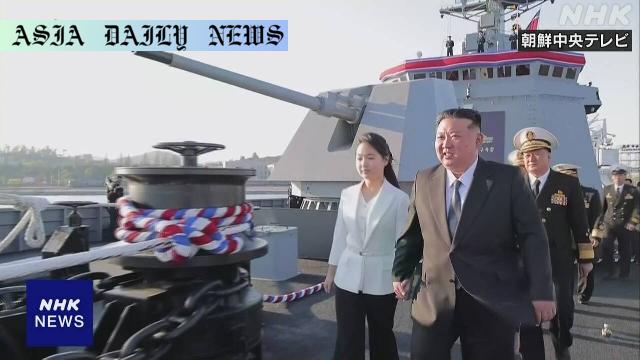Destroyer: North Korean leader Kim Jong Un unveils a powerful 5,000-ton destroyer equipped with advanced missile systems.
The destroyer is equipped with supersonic cruise missiles and tactical ballistic missiles.
The vessel holds 74 vertical launch missile cells, potentially including nuclear options.
Kim Jong Un emphasizes developing an offshore-operating fleet and nuclear submarines.
The launch aligns with North Korea’s military anniversary celebration.

Introduction to North Korea’s New Maritime Milestone
North Korea’s leader, Kim Jong Un, recently attended a significant launch ceremony for a new 5,000-ton destroyer in Nampho. The event, conducted on Friday and aired on state-run television the following day, showcases the nation’s ongoing advancements in military technology. This development is aligned with Kim’s broader goals of enhancing North Korea’s defense strategy, especially in maritime areas.
Key Features of the 5,000-Ton Destroyer
The destroyer represents a new generation of naval warfare capabilities for North Korea. Equipped with supersonic strategic cruise missiles and tactical ballistic missiles, the vessel aims to bolster its deterrence capabilities against potential adversaries. State television footage highlighted the ship’s advanced radar systems, air defense mechanisms, and vertical launch systems. Notably, South Korean media speculates that the destroyer houses 74 cells for vertical missile launches, possibly including nuclear-equipped missiles. Such a configuration suggests that the vessel is not only a defensive asset but also a critical offensive tool with potentially far-reaching strategic implications.
Strategic Goals Behind the Launch
During the ceremony, Kim Jong Un articulated a vision for a robust naval fleet capable of operating far beyond North Korea’s coastal waters. He emphasized the importance of stopping enemy reinforcements during a potential emergency on the Korean Peninsula. This aligns with the country’s five-year national defense plan, which includes the ambition to develop nuclear-powered submarines. The destroyer is seen as a key milestone in achieving this broader goal, marking a significant shift in North Korea’s naval doctrine.
Geopolitical Ramifications
The unveiling of this destroyer raises concerns across the region, particularly in South Korea, Japan, and the United States. The prospect of a vessel equipped with nuclear missile capabilities adds another layer of tension to North-East Asia’s already volatile security landscape. Moreover, the announcement of plans to build nuclear-powered submarines further underscores North Korea’s intent to project power and assert its strategic autonomy on the global stage. Both regional and global powers are likely to respond with heightened vigilance and potentially increased military preparedness.
Significance of the Timing
The launch occurred on a military anniversary, reinforcing its symbolic and strategic importance. By linking the destroyer’s unveiling to a historical occasion, Kim Jong Un aims to rally domestic support while sending a message of strength to foreign adversaries. The emphasis on technological sophistication and self-reliance reflects North Korea’s continued efforts to demonstrate resilience against international sanctions and diplomatic isolation.
Looking Ahead
As North Korea advances its naval capabilities, it is crucial to assess the broader implications for regional stability. The development of nuclear-powered vessels and enhanced offshore-operating fleets suggests a long-term strategy to secure maritime dominance while deterring external threats. How the international community chooses to respond, be it through diplomatic channels or increased military cooperation, will significantly influence the region’s future security dynamics.



Commentary
The Symbolism Behind North Korea’s Naval Advancements
North Korea’s recent launch of a 5,000-ton destroyer is not just an engineering milestone but a highly symbolic act in the country’s geopolitical playbook. By unveiling this advanced vessel during a military anniversary, Kim Jong Un has skillfully highlighted his regime’s technical prowess while evoking patriotic sentiment within his nation. The significant media coverage surrounding the event also underscores its role as a strategic deterrent aimed at communicating strength to perceived adversaries like South Korea, Japan, and the United States.
A New Chapter in Naval Strategy
Beyond the immediate symbolism, this launch represents a fundamental shift in North Korea’s approach to naval operations. Historically focused on defensive measures, the development of a fleet capable of operating far offshore signals an intent to assert influence beyond its territorial waters. The inclusion of advanced missile systems, potentially nuclear-equipped, adds a concerning dimension to these developments. This move reflects Kim’s broader defense strategy, which emphasizes a mix of traditional deterrence and cutting-edge technological capabilities.
Regional and Global Reactions
The unveiling of this destroyer is likely to provoke a range of responses from regional powers and the broader international community. Countries like South Korea and Japan may ramp up their own military investments, while the United States could intensify its surveillance and cooperative defense measures in the region. Diplomatically, this development might complicate efforts to re-engage North Korea in meaningful negotiations, as it signals a clear prioritization of military strength over diplomatic rapprochement.
Conclusion: A Pivotal Moment in Regional Security
North Korea’s launch of a 5,000-ton destroyer is a landmark event with far-reaching implications. While it demonstrates impressive technological advancements, it also heightens tensions in an already fragile regional security landscape. Moving forward, it will be critical for both regional and global stakeholders to carefully navigate these developments, balancing the need for preparedness with opportunities for dialogue. Failure to do so could result in an escalation of hostilities, underscoring the high stakes involved in North Korea’s latest military initiative.